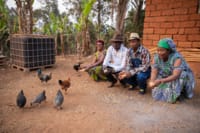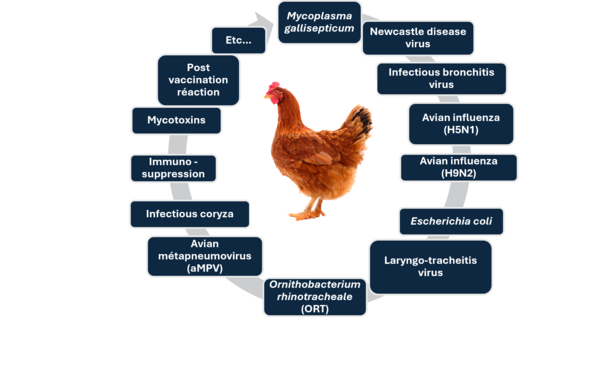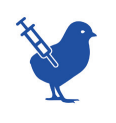CONTEXT
|
HEALTH RISKS Chicks can be exposed to numerous pathogens. They are sensitive to bacteria and viruses present in the environment. Sometimes, it is a combination of several diseases. Chronic respiratory syndrome, for example, is due to a combination of respiratory viruses and poor farm management. |
HEALTH EVOLUTION The evolution of viruses in poultry farming is a complex and important topic, given the potentially devastating impact of viral diseases on poultry populations. Genetic mutations can lead to the emergence of new viral strains. These new strains can be more virulent, spread more quickly, and infect at an earlier stage, posing additional challenges in terms of avian disease prophylaxis. Some viruses can cause zoonotic diseases, such as avian influenza, and can have serious implications for public health. |
WHAT WE INCREASINGLY NEED |
Good biosecurity | Early vaccination | New technologies | Stronger prophylaxis |
|---|---|---|---|

 Corporate Website
Corporate Website
 Africa
Africa
 Argentina
Argentina
 Asia
Asia
 Australia
Australia
 Belgium
Belgium
 Brazil
Brazil
 Bulgaria
Bulgaria
 Canada (EN)
Canada (EN)
 Chile
Chile
 China
China
 Colombia
Colombia
 Denmark
Denmark
 Egypt
Egypt
 France
France
 Germany
Germany
 Greece
Greece
 Hungary
Hungary
 Indonesia
Indonesia
 Italia
Italia
 India
India
 Japan
Japan
 Korea
Korea
 Malaysia
Malaysia
 Mexico
Mexico
 Middle East
Middle East
 Netherlands
Netherlands
 Peru
Peru
 Philippines
Philippines
 Poland
Poland
 Portugal
Portugal
 Romania
Romania
 Russia
Russia
 South Africa
South Africa
 Spain
Spain
 Sweden
Sweden
 Thailand
Thailand
 Tunisia
Tunisia
 Turkey
Turkey
 Ukraine
Ukraine
 United Kingdom
United Kingdom
 USA
USA
 Vietnam
Vietnam








